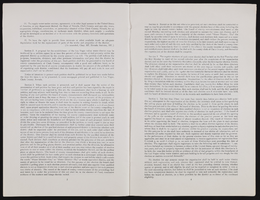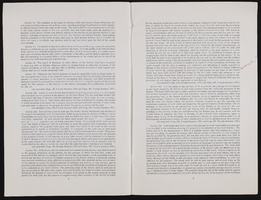Search the Special Collections and Archives Portal
Search Results
Richard D. Chase oral history interview
Identifier
Abstract
Oral history interview with Richard D. Chase conducted by Helen Rondthaler on October 17, 1972 for the Ralph Roske Oral History Project on Early Las Vegas. Chase discusses the history of Las Vegas, Nevada from 1945, touching on topics such as the housing shortage during the 1940s, The Red Rooster swingers’ club, Billy Moore, Sam Larson, Ira Goldring, atomic bomb testing, and the Nevada environment. Chase discusses the importance of construction-based labor to the development of Southern Nevada. Chase also explains at length the impact of the Nevada Test Site on his construction company.
Archival Collection
Las Vegas Rotary Club Records
Identifier
Abstract
The Las Vegas Rotary Club Records (1981-2022) contain award certificates, club directories and rosters, Las Vegas Rotary publications, commemorative material including a 20-foot by 34-foot velvet curtain. The collection also contains plastic and metal Rotary Club signs from across the United States and international locations, material from a Rotary Club in Africa, and a digital video segment made in 2013 about the history of the Las Vegas Rotary.
Archival Collection
Ethlyn Barneby oral history interview
Identifier
Abstract
Oral history interview with Ethlyn Barneby conducted by Claytee White on October 16, 2002 for the Boyer Early Las Vegas Oral History Project. During this interview Barneby discusses her experiences as a resident of Boulder City, Nevada during the 1940s. Barneby also discusses life with her husband, a member of the National Guard, and her husband’s employment as an operator for the City of Los Angeles, California during the construction of the Hoover Dam. She also describes their experiences moving back and forth between Boulder City and Los Angeles as well as the growth of Boulder City in relation to Las Vegas, Nevada.
Archival Collection
Joan Olson Griffith oral history interview
Identifier
Abstract
Oral history interview with Joan Olson Griffith conducted by Sharee Schrader on April 12, 2005 for the History of Blue Diamond Village in Nevada Oral History Project. Griffith begins by discussing why she moved to Blue Diamond, Nevada with her family due to job opportunities at the Blue Diamond Plant, where they manufactured wallboard, in 1956. She describes life in Blue Diamond and rural Nevada, the education available in the village, and Blue Diamond's proximity to Bonnie Springs Ranch and structures made for the filming of Western themed media. Griffith concludes by discussing how Blue Diamond has changed since the 1950s and being a Sunday school teacher for eighteen years.
Archival Collection
Ned V. Bearden Sr. Photograph Collection
Identifier
Abstract
The Ned V. Bearden Sr. Photograph Collection contains black-and-white photographic prints and negatives of early Las Vegas, Nevada Fremont Street hotels, casinos, as well as Las Vegas businesses and residences between approximately 1940 to 1960. These photographs detail air conditioning units installations by Bearden throughout Las Vegas.
Archival Collection
Byrd Wall Sawyer Photograph Collection
Identifier
Abstract
The Byrd Wall Sawyer Photograph Collection contains color photographic slides depicting Byrd Wall Sawyer’s home, the Carson House, in Carson City, Nevada; towns and cities; and landscapes throughout Nevada between approximately 1950 to 1970. Nevada towns and cities primarily depicted include Belmont, Manhattan, Reno, and Dixie. Nevada landscapes include Carson River, Carson Mountains, Olinghouse Canyon, Washoe Lake, King’s Canyon, Lake Winnemucca, Washoe Valley, and Lake Tahoe.
Archival Collection
John West oral history interview
Identifier
Abstract
Oral history interview with John West conducted by Claytee D. White on August 10, 2000 for the Boyer Early Las Vegas Oral History Project. In this interview, West discusses his family background and arriving to Las Vegas, Nevada in 1954. West describes his educational experiences in Las Vegas and his career as a clinical psychologist. He recalls his father’s career in medicine and becoming the first African American licensed medical doctor in Las Vegas. West then talks about attending entertainment events before race integration was introduced, and the voting patterns in West Las Vegas. Lastly, West discusses his father’s decision to remain living in West Las Vegas and operating his medical office there after integration.
Archival Collection

Michael Arage oral history interview: transcript
Date
Archival Collection
Description
Oral history interview with Michael Arage conducted by Dalton DuPré on November 12, 2021 for Reflections: The Las Vegas Asian American and Pacific Islander Oral History Project. In this interview, Michael Arage discusses his upbringing in the Greater Toronto Area (GTA), Ontario, Canada with his sister and his Filipino-Palestinian heritage. He talks about how his parents immigrated to the United States, his life and education in Toronto, and his relocation to Los Angeles, California where he married his wife. Michael Arage shares how the couple moved to Las Vegas, Nevada in 2012 when his wife started a job at Zappos. Because he lacked a work visa, Michael Arage began playing poker and working in sports betting. In 2019, he founded a community organization to support the people of Palestine, called Nevadans for Palestinian Human Rights. Michael Arage talks about his activism efforts, anti-Arab racism, his cultural upbringing, and of Filipino and Arabic foods and customs. He also shares his views of living in Las Vegas, the difficulties of raising a child away from her cousins, and differing governmental policies and healthcare between Canada and the United States.
Text


